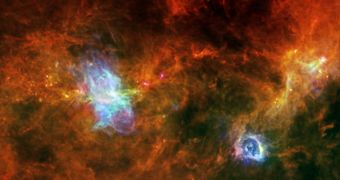Astronomers handling the data flowing out from the European Space Agency's (ESA) Herschel Space Observatory have just published a new image collected by the world's most complex telescope. The dataset covers the Vela C region, one of four such areas in the much-larger Vela Complex.
The latter is a stellar nursery, a region of space that features a massive amount of cosmic dust and molecular hydrogen gas. The gas tends to come together around gravity nuclei, and form impressive clouds. As they acquire more and more mass, these clouds at one point exceed their stability limits.
When this happens, they implode under their own weight, compacting into a new cosmic object. This collapse creates a tremendous amount of friction, which heats up the gas until it manages to achieve nuclear fusion. Thus, a protostar is born.
Stellar nurseries are areas where this processes occur simultaneously at numerous locations, and which have significant gas reserves to sustain this rate of forming new stars for a long time. Herschel recently observed one segment of such an area.
The Vela Complex is located just 2,300 light-years away from Earth, which is relatively close in astronomical terms. Vela C is the largest of its four parts, and has been used by astronomers as a natural laboratory for the studying of new stars for several years.
“The eye is immediately drawn to two prominent features in this image: a delicate blue and yellow butterfly shape just right of center that appears to be flying towards a nest of coiled blue material in the lower right,” ESA scientists say in a press release.
“These regions stand out from their surroundings because their dust has been heated by young hot stars. A cluster of very hot, massive stars are strung out along the butterfly’s ‘body’, their radiation heating up the surrounding dust seen as yellow in this scene,” the investigators go on to say.
Many stars in Vela C are massive ones, meaning that they will only survive for just tens of millions of years, before exploding in large supernova blasts. Generally speaking, massive stars cannot survive for the lengths of time a G-type yellow dwarf like the Sun can endure.
Currently, our star is around 4.6 billion years old, and is expected to continue fusing hydrogen into helium for at least 5 billion years more. After that time, it will switch to burning helium, a change that will be marked by its transformation into a red giant, and a white dwarf.
As a white dwarf, the Sun will endure for an additional 3 billion years or so, which means that its total lifespan will come close to 13 billion years, just 750 million years fewer than the current age of the Universe.

 14 DAY TRIAL //
14 DAY TRIAL //